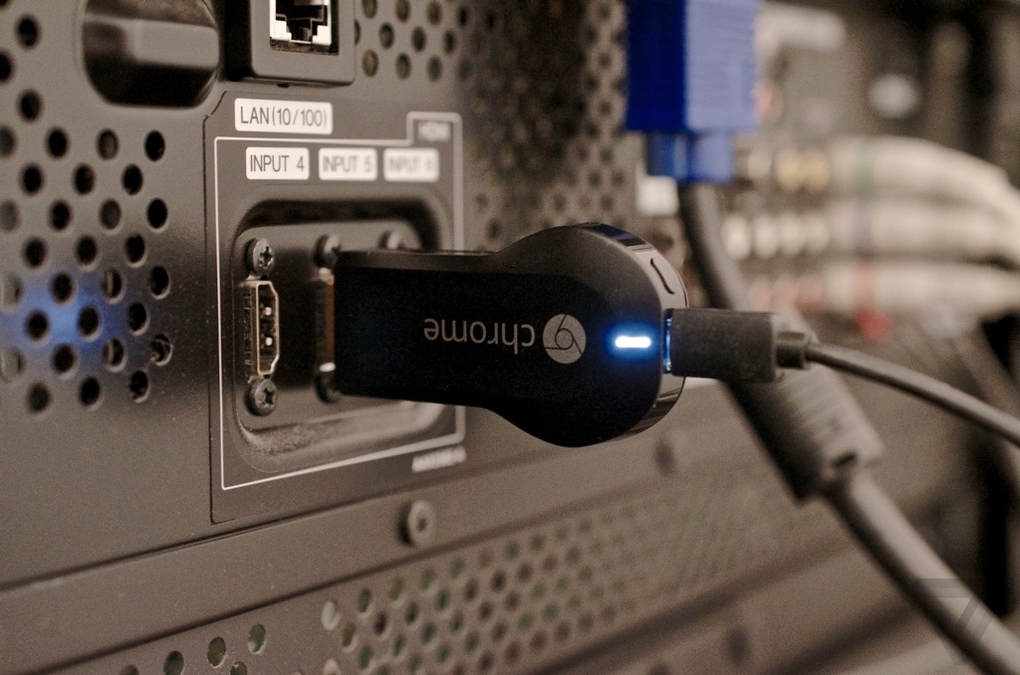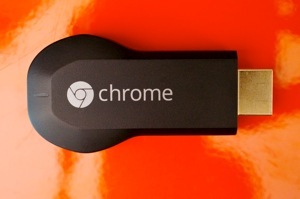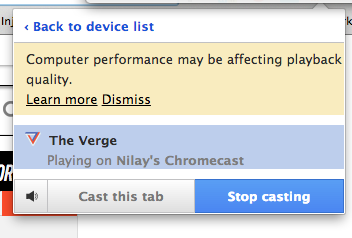Sexy Chromecast trick: It can play video files from any computer
Forget streaming from Netflix and all that jazz. Chromecast can play back MP4 files (and other formats) from your PC or Mac like a champ.
Google's Chromecast turns me on, but it doesn't really compel me as I've got several streaming solutions in my home. At least, that's what I thought until I read Thursday that Chromecast can play video files on any computer connected to the streaming dongle.
This is huge news for those who thought Chromecast is just another glorified streamer.
As pointed out by Droid Life, a Chromecast can play back local video files hosted on a computer running Google Chrome with theChromecast extension installed.
To access files hosted on the computer and play them on a Chromecast-enabled TV, a Chrome user simply needs to access their file directory by hitting Ctrl+O (or Command+O on a Mac) and select the desired video file. Voila! Playback. You can also just drag and drop the video into the Chrome Web browser.
If you happen to notice choppiness during streaming, it may be due to your router not having enough transmission speed to stream effectively -- 802.11n routers seem to work best, according to several comments I've seen.
Astute Chromecast users have already figured out that the Chromecast can stream AVI, MPEG, and MP4 video files from their computers, but it appears MKV files only play video, with no audio. Despite that setback, this newly discovered functionality could enhance the appeal of the $35 device. Does this unannounced feature make Chromecast more attractive to you?

For more, check out July 29th's Top Shelf: the Droid days of summer






Google Chromecast review
Google takes on AirPlay and finally puts a browser on your TV

It’s
surprisingly difficult to put a web browser on TV. It’s difficult for
regular people — the best option is often just plugging in a laptop —
and it’s been ridiculously difficult for the tech industry in general.
From interface problems to weird remotes to clunky performance, attempts
to put the web on TV have all met with failure of one kind or another.
Google in particular learned a hard lesson with its Google TV platform,
which crashed and burned so spectacularly when it launched in 2010 that
hardware partner Logitech nearly went out of business.
But now Google’s back with the Chromecast,
a far simpler way of getting the web on your TV. The Chromecast is a
$35 HDMI dongle that basically competes with Apple’s AirPlay system:
when you use supported services like YouTube and Netflix on your phone,
tablet, or computer, hitting the new Cast button sends the video to your
TV. You can also send entire tabs from the Chrome browser on Macs and
PCs, which means you can basically put any site or service on TV with
just the click of a button. That opens up an entire world of content for
your TV — far more than any other service can offer on its own.
It’s all very promising,
especially for the price — there was such a rush to buy the Chromecast
after it was announced last week that Google had to cancel a three-month
Netflix promotion. And after a few days of testing, it seems like the
Chromecast might actually deliver on all that potential, but Google
still has a lot of work to do.
For more, check out July 29th's Top Shelf: the Droid days of summer
Getting started
There's not much to say about
the Chromecast itself aside from the fact that it provides a legitimate
reason to say the word "dongle," which is great fun. The whole thing is a
little under 3 inches long, and it'll stick out about 2.5 inches when
plugged into an HDMI port. That can lead to some problems if you bump
into it or otherwise jostle it around — I bent the HDMI connector on one
of my Chromecasts within minutes of plugging it in. (It still works,
but it wasn't exactly reassuring.) There's a short HDMI extension cable
in the box to provide extra clearance if you can't fit the Chromecast
against the back of your TV, but you might need something longer
depending on your setup, as the extension really just makes everything
stick out more. Out of the box, this dongle don't dangle.
This dongle don't dangle

On the back there's an LED, a
button, and a Micro USB port, which is how the Chromecast gets power.
Yes, power — Google actually recommends that you use the included
external power adapter to plug the Chromecast into the wall. I suspect
that's so the Chromecast stays on even when the TV is off, allowing it
to turn on the TV and switch inputs using HDMI control if your TV
supports it. You can also plug the Chromecast into your TV's USB port if
it has one, but on my Samsung office TV those ports turn off when the
TV does, shutting down the Chromecast as well. If you have a newer TV
with HDMI 1.4 ports, you might find they can power the Chromecast
directly, although Google isn't clear about how officially supported
that is.
It's all a little more cable
clutter than I expected, but it's not the end of the world. Just don't
expect to toss the Chromecast in your bag and go — you'll need external
power for most TVs you find out in the world.
Once you've got the Chromecast
plugged in and powered, the next step is getting it on your Wi-Fi
network, which is easy: you download the setup app for Mac, PC, or
Android, and it prompts you to choose your network and type in your
password. (Only 2.4GHz networks are supported, which is a little bit of a
bummer.) After that, you give your Chromecast a name, install the
Google Cast Chrome extension on your computer, and you're all done.
There's nothing else you need to configure or interact with the
Chromecast itself — all the action moves to apps and your computer.

Casting about for fun and profit
The Chromecast is basically a
small Android computer that can connect to the internet and play video
files. When you hit the Cast button in a supported app, the Chromecast
directly connects to the internet and streams the video itself — it's
not streaming from your device. (Apple's AirPlay also works like this in some cases, but it can also stream audio and video directly from iPhones, iPads, and iTunes on the Mac and PC.)
The only apps that support the
Chromecast out of the box are YouTube, Netflix, and Google's various
Play media apps. Using them is simple: you just find whatever you want
to watch, hit the Cast button, and the Chromecast takes over while your
device becomes a remote. And since the Chromecast is connecting directly
you can switch apps, open new tabs, and even turn things off without
interrupting playback. It's all very flexible, and when it works, it's
super smooth. Netflix knows when it's playing through the Chromecast,
and opening any Netflix app connected to your account allows you to
control the video. And it all works everywhere: iOS, Mac, and Windows
included. I quickly flipped back and forth between platforms while
watching Arrested Development, and everything worked fairly well,
although I did manage to get the Netflix iPhone app confused about what
was playing a few times.
Chromecast streams from the internet, not your device

All that flexibility can lead
to some confusion. Since there's no single, definitive place to control
the Chromecast, it's easy to find yourself watching a video without any
immediate way to pause, rewind, or mute — you have to remember where the
video came from and open that app. It's not a big problem, but it's
added complexity. Google really needs to add basic playback controls
like play, pause, and mute to the Chromecast setup app. Google also
desperately needs to add in some basic password controls; right now
anyone walking by can grab control of your Chromecast and send video to
it. That makes it super easy to use, but also opens up a world of
elaborate trolling.
That's it for app support.
Unlike AirPlay, which is built into the system video player on iOS and
integrated into OS X, Chromecast requires app developers to add support
to every app individually. That's going to take time and some intense
lobbying from Google. Pandora support is coming, but unless you're a
heavy Google Play user, right now the Chromecast's entire app story is
Netflix and YouTube.

But let's be honest: you're
not buying a Chromecast for Netflix and YouTube, services that are
basically everywhere. (There are probably toasters that run Netflix at
this point.) What $35 really buys you is the simplest possible way to
send tabs from Chrome to your TV screen, and it works. It works really
well, in fact; if you can see it in Chrome, you can get it on your TV,
with only a few exceptions.

Anything from your browser to your TV, with the touch of a button
Netflix and YouTube have dedicated Chromecast buttons, but full-screen Flash video works just fine everywhere else: I tested The Verge's
video player, Vimeo, ESPN, Hulu, and a few others, and hitting the
full-screen button blew up the video to fill the entire TV screen. Music
services like Pandora, Spotify, and Rdio all worked fine as well. You
can also drag files from your desktop into Chrome and they'll play as
well, as long as Chrome supports them natively. (Video in .mp4 format
and .mp3 audio files work great.) The only real incompatibility is with
Apple's QuickTime — you'll see the video on your TV just fine, but the
audio will still come out of your computer. That means Apple's movie
trailer site doesn't work, and .mov files you drag into Chrome won't
either.
Once I had the ability to
throw anything in my browser onto a TV with the press of a button, I
found myself doing it all the time, for seemingly no reason. Having a
button in YouTube that lets you play a video on a TV is particularly
great; I use AirPlay in the iOS YouTube app all the time, but search and
discovery is still so much better on a laptop that it makes for a whole
different experience. Same with The Verge's video hub
— I spent a few hours catching up on everything we made in the past
week while writing this review and going through my email, and having
control of everything from my laptop was far better than my usual system
of having an iPad next to me just for streaming video over AirPlay.
It's kind of like using your TV as a gigantic second monitor.

This
is all definitely for lean-back consumption only, and you shouldn't
expect to use the TV as your main screen, even though there's an
"experimental" setting that lets you share your entire screen and not
just a single tab. The mouse cursor isn't displayed, and there's a very
noticeable delay between what happens on your computer and what happens
on the TV. Everything is captured and streamed at a maximum resolution
of 720p; you can choose a higher bitrate if you have the bandwidth or
step down to 480p if your network is slow. You can also select "Audio
Mode" in the Chromecast browser menu to lower the video frame-rate and
bandwidth usage if you're listening to a music service. It's kind of
weird — Audio Mode should probably just black out the video entirely.
Google says the tab casting
feature is in beta, and it shows. Even at the highest quality video
playback isn't perfectly smooth, and there are some glitches here and
there. You'll also need a decently powerful machine: performance on my
older Samsung Series 5 Chromebook
was so terrible it was unusable, and I occasionally got performance
warnings on my Core i7 MacBook Pro as well. But for the most part it
works, and it works well enough to use regularly. I use a utility called
AirParrot to send app windows to my Apple TV over AirPlay all the time,
and Chromecast definitely works just as well — the improved AirPlay
support coming in OS X Mavericks will probably be better than either
solution, but for right now it's a wash. And if you're a Windows user,
it's by far your best option.
Wrap-up
Google Chromecast
Good Stuff
- Inexpensive and simple
- Supported apps work well
- Chrome tab casting is very useful
Bad Stuff
- App support limited to Netflix, YouTube, and Google Play
- Tab casting video drops frames
- No central playback controls
Not much of an AirPlay competitor, but a great wireless display for Chrome
The
Chromecast is basically an impulse purchase that just happens to be the
simplest, cheapest, and best solution for getting a browser window on
your TV. Everything else, including the potential for app support, is
secondary — Google has a lot of work to do catching up to Apple and
AirPlay on that front, and those deals aren’t easy. It took Apple years
to get HBO to add AirPlay support to HBO Go on the iPad, for example.
History suggests that counting on Google to convince content companies
to add Chromecast support to their apps is a foolish bet. And if all you
want is Netflix, spend $50 on a Roku — it’s better all the way around.
But if you’re the type who
routinely watches things on a laptop and just wants an easier, cleaner
way to get those things on a TV, the Chromecast is a no-brainer. Think
of it as a wireless display cable for your laptop and you’ll get the
potential immediately — there’s a reason all these companies have been
trying to put a browser on TV for the past 15 years. I have no idea if
Google can build the Chromecast ecosystem into something rivals AirPlay,
but for $35 I’ll be too busy sending tabs from Chrome to really even
care.


